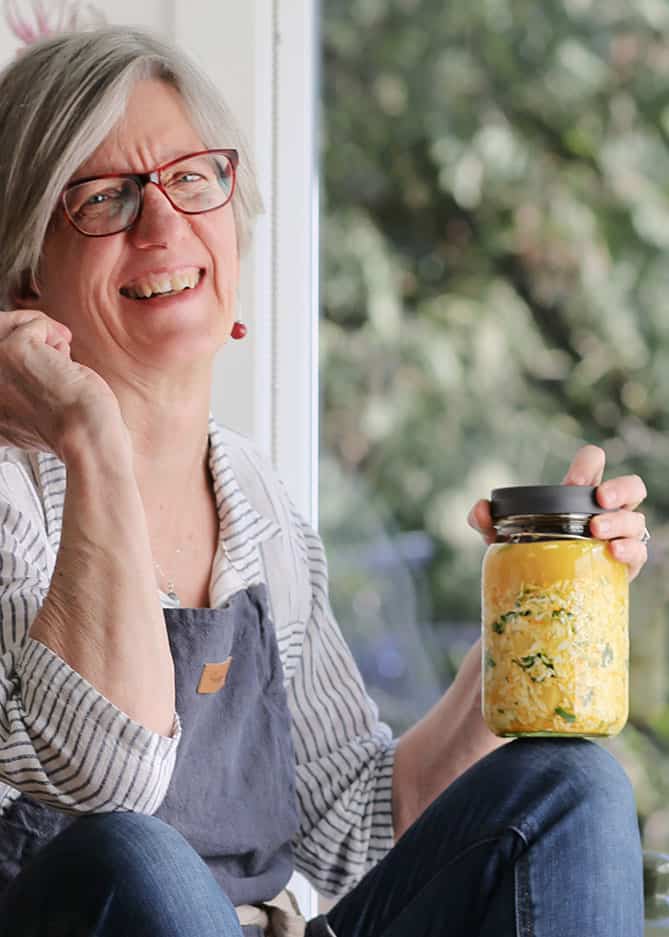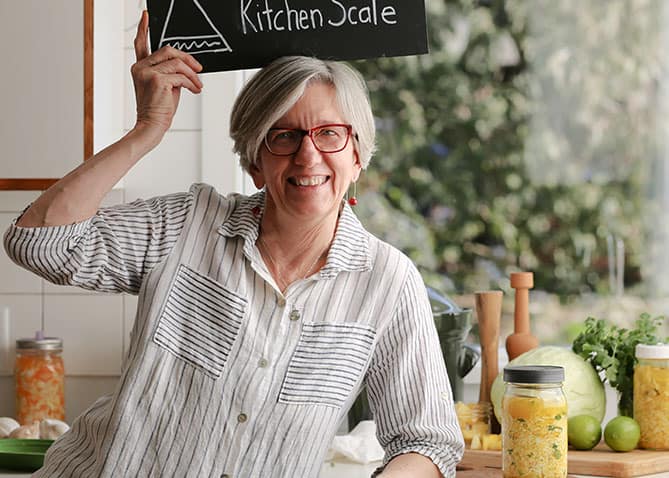Choosing the right fermentation weight and airlock for your fermentation project is an important step for stellar results without loss of brine or mold growth. The Masontops Pickle Pebble and Pickle Pipe are innovative tools designed to make the process of fermentation easier and more efficient. Discover when to use them and… when NOT to use them.
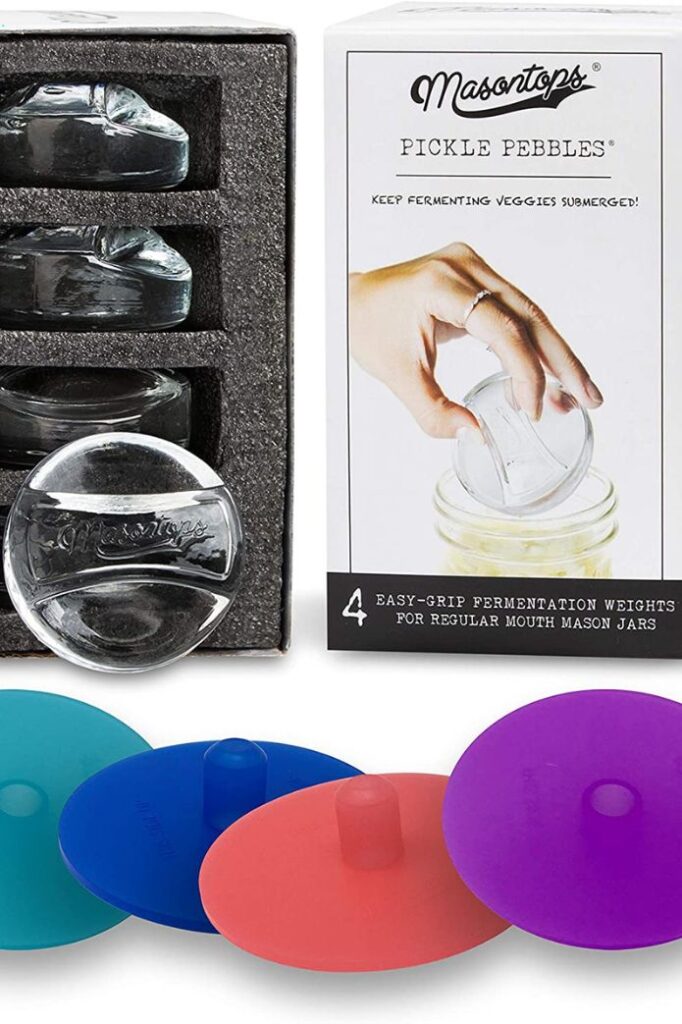
In this guide, I review the Pickle Pebble and the Pickle Pipe and share:
- What they are?
- How they work?
- If they work?
- And, what type of ferments that they work best with?
During twenty-plus years of fermenting sauerkraut, kimchi, pickles, pastes, relishes, and chutneys, I’ve tried homemade devices, along with testing just about every fermentation weight and airlock on the market.
Some weights work best with sauerkraut, keeping everything safely under the brine, but not so great with pickles. And, vice-versa.
Read on to discover when to use Masontops Pickles Pebbles and Pickle Pebbles, and… when NOT to use them.
My reviews on other weights, along with airlocks. for fermenting include:
The PickleHelix Fermentation Kit by Trellis Review [INNOVATIVE]
Kraut Source Fermentation Lid REVIEW [Solid Design]
ViscoDisc Canning Buddies REVIEW [Simple & Affordable]
Pickle-Pushing No-Float Jar-Packer Review: Ingenious
For homemade weight options, see: Fermentation Weights: Keep Your Ferments Below the Brine
Quick Summary: What I Use
Select a fermentation weight based on what works best with what you’re fermenting (explained below). The lid (airlock) is not as important as the weight. You can use the airlock that comes with the weight or another airlock that you already own.
Sauerkraut: Favorite Fermentation Weight
Pickles: Favorite Fermentation Weight
The ViscoDisc Canning Buddies (my review HERE) are often out of stock on Amazon but can be found at Fermentation Revolution and HeyDay Fermentables.
Masontops Fermentation Weights and Airlocks
What are Pickle Pebbles and Pickle Pipes?
The Pickle Pebble is a glass fermentation weight that sits on top of the vegetables in the jar, designed to keep them submerged in the brine and prevent spoilage.
The Pickle Pipe is a silicone airlock that fits onto the lid of a wide-mouth (or, regular-mouth) Mason jar, allowing for the release of carbon dioxide during fermentation while preventing oxygen from entering the jar.
Together, the Pickle Pebble and Pickle Pipe create a simple and effective system for making delicious and healthy ferments at home.
Pros and Cons of the Pickle Pebble
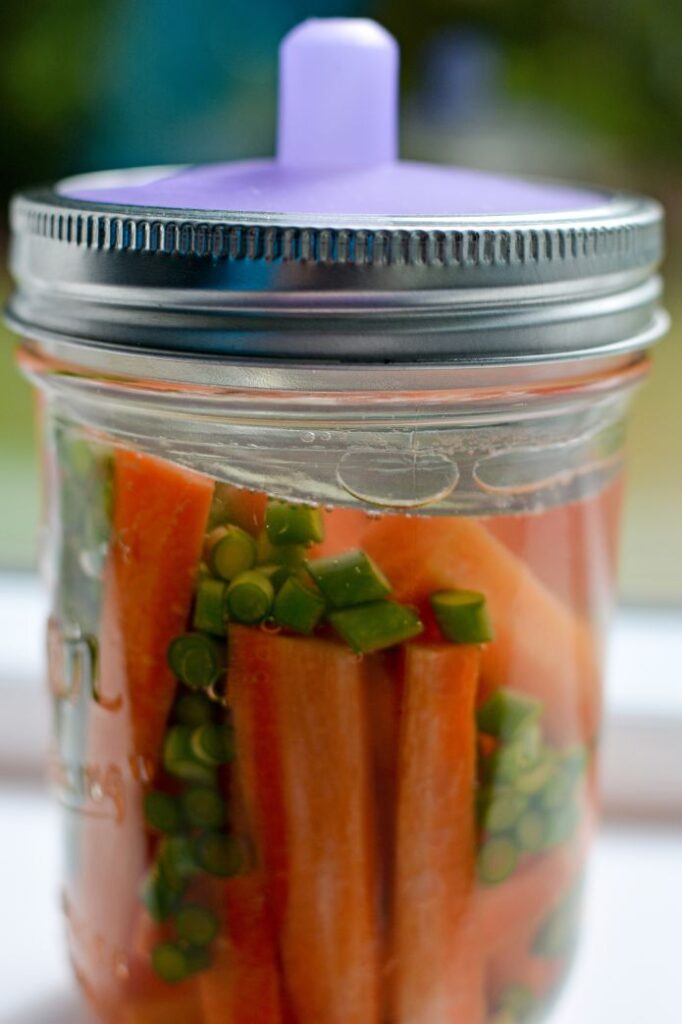
Pickle Pebbles are clear glass weights designed to hold your ferment below the surface of the brine thereby eliminating exposure to oxygen, one of the main causes of failure when fermenting various vegetables and fruits.
✅ Made from lead-free, non-iridized soda glass. This is the same material glass canning jars are made from, a material that guarantees nothing will leach into your ferment.
✅ Won’t absorb odors. Glass is non-porous and won’t stain or pick up odors as plastic or silicone will.
✅ Durable. Like Mason jars, Pickle Pebbles will last forever and do not easily break.
✅ Compact. The Pickle Pebble does not take up a whole lot of space in your jar, leaving more space for brine.
✅ Available in Two Sizes. Pickle Pebbles and Pickle Pipes are available in both regular mouth and wide mouth sizes to meet all your fermentation needs.
![]() Can be difficult to grab. Masontops has updated its design to include a round knob to make it easier to remove from the jar. Slippery brine and the size of your hands can still interfere with the easy removal of glass weights.
Can be difficult to grab. Masontops has updated its design to include a round knob to make it easier to remove from the jar. Slippery brine and the size of your hands can still interfere with the easy removal of glass weights.
![]() Not heavy enough for all types of ferments. The weight of the Pickle Pebble will determine how well it is able to hold a ferment below the brine.
Not heavy enough for all types of ferments. The weight of the Pickle Pebble will determine how well it is able to hold a ferment below the brine.
During the fermentation process of sauerkraut and kimchi, gases build up in the packed mixture and cause it to “heave,” or move up and out of the brine. There is not enough weight in a Pickle Pebble to keep sauerkraut and kimchi safely below the brine.
Pickle Pebbles, and other glass fermentation weights, were designed to mimic the traditional process of fermenting sauerkraut in large crocks where weight (a plate with a large jar filled with water) was used to hold everything below the brine. In a small canning jar, there is not enough room to place a heavy enough weight.
They don’t work well with sauerkraut, kimchi, pastes, chutneys, or relishes.
They work great with pickles (loose vegetables packed into a watery brine) where gases easily escape and don’t cause the packed vegetables to “heave.”
They don’t work well with fermented pastes and relishes where typically no brine is created which the Pickle Pebble can do its job.
Pros & Cons of the Pickle Pipe
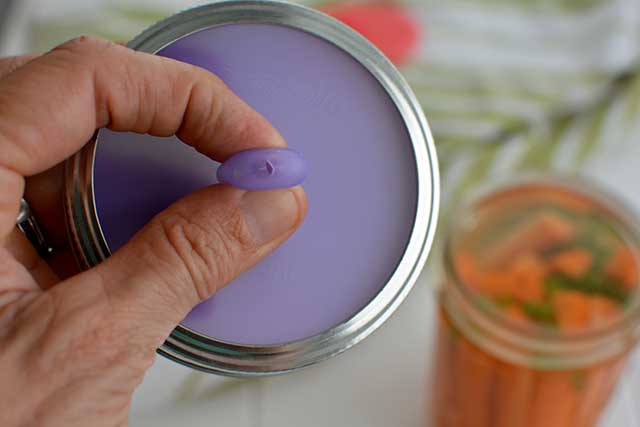
Pickle Pipes are a unique one-way silicone valve designed for use with any sized mason jar. A cross-hatch cut into the nipple of the top releases the gasses created by fermentation while preventing oxygen from getting into the jar.
✅ Waterless. Many fermenters first started with the 3-piece airlocks used in the beer and wine industry which need the water in them topped up.
✅ Made from BPA-free and phthalate-free silicone, substances that may be harmful over time when inadvertently consumed due to leaching out of the silicone.
✅ Low profile. The Pickle Pipe protrudes above your jar by just about a half-inch, leaving you space to keep jars under cabinets, a nice feature if you are fermenting in tall jars.
✅ No little pieces to keep track of. There is no need to fumble with multi-piece airlocks that are difficult to clean and store.
✅ Provide visual feedback. My favorite feature! Gases, produced by the bacteria during the fermentation process, build up and create a slight bulge in the lid. A nice assurance that something is happening in your fermentation jar.
✅ Two sizes. Available for both regular-mouth and wide-mouth jars.
✅ Easy to care for. Both the Pickle Pebbles and Pickle Pipes can be washed in the dishwasher.
![]() Absorbs odors. Silicone will absorb odors, especially garlic, onions, and hot peppers, but I have you covered: Best Way to Remove Odors from Plastic and Silicone [2 ESSENTIAL KEYS]
Absorbs odors. Silicone will absorb odors, especially garlic, onions, and hot peppers, but I have you covered: Best Way to Remove Odors from Plastic and Silicone [2 ESSENTIAL KEYS]
![]() Airlock can become clogged. During fermentation, brine can bubble up into the Pickle Pipe, crust over, and clog, thus becoming difficult to clean.
Airlock can become clogged. During fermentation, brine can bubble up into the Pickle Pipe, crust over, and clog, thus becoming difficult to clean.
![]() Lose color. Over time, the nice colors of the Pickle Pipe fade.
Lose color. Over time, the nice colors of the Pickle Pipe fade.
![]() Must use your own metal band. The metal band needed to secure the Pickle Pipe is not included but most of us have them around the home.
Must use your own metal band. The metal band needed to secure the Pickle Pipe is not included but most of us have them around the home.
![]() The Pickle Pipes need to be stored flat, so keep the case they came in and make use of it.
The Pickle Pipes need to be stored flat, so keep the case they came in and make use of it.
![]() The metal band used to hold the Pickle Pipe in place can stick to the jar and be very hard to remove. Something about the combination of the metal band with dried and sticky brine.
The metal band used to hold the Pickle Pipe in place can stick to the jar and be very hard to remove. Something about the combination of the metal band with dried and sticky brine.
Lastly, resist the temptation to give the colorful little Pickle Pipe a squeeze when checking your ferments. Doing so would let in air, defeating the purpose of the Pickle Pipe.
Masontops Weights and Airlocks Options
Pickle Pebbles and Pickle Pipes are sold separately or in kits. They come in two sizes: regular-mouth and wide-mouth. Be sure to select the correct size for your jar.
- MASONTOPS COMPLETE MASON JAR FERMENTATION KIT: Includes all the tools needed to turn your...
- 9 PC FERMENTATION STARTER KIT INCLUDES: 4 Pickle Pipe fermentation lids for wide mouth mason...
- MAKE YOUR OWN DELICIOUS PROBIOTIC SUPERFOODS: Ferment vegetables (carrots, pickles & radishes...
- GET THE CRITICAL TOOLS FOR THE HOME FERMENTER: Have pro supplies on hand to convert wide mouth...
- 8 PC SET INCLUDES: 4 Wide Mouth Pickle Pipes & 4 Pickle Pebble Glass Weights. The waterless...
- MAKE DELICIOUS PROBIOTIC SUPERFOODS: Ferment veggies (carrots, pickles & radishes etc.) in a...
- EASIEST MASON JAR FERMENTING AIRLOCK: These premium quality self burping ferment caps have a...
- FOOLPROOF FERMENTATION: Fermenting veggies is tricky without the right pickling supplies and...
- MAKE PROBIOTIC-RICH FOOD AT HOME: Ferment your own sauerkraut, pickles, kimchi & more. Pickle...
About the Masontops Company
Masontops—a company located in Toronto, Canada—whose name includes the inventor of the glass canning jar, is all about making the canning jar work better for you by providing unique and helpful tools to convert your canning jars into powerful workhorses.
Phil Baron, the inventor of the Pickle Pipe and founder of Masontops, launched his company in 2013. Production of Pickle Pipes was funded by a successful Kickstarter campaign in October 2015.
MasonTops Pickle Pebbles and Pickle Pipes in Action
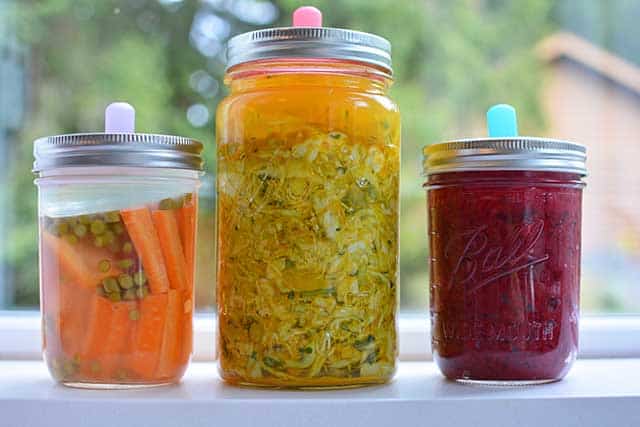
The Pickle Pipe airlocks can work with just about any ferment. Through years of making various types of ferments, I found that the Pickle Pebbles weights work great in some setups and not so great in other setups.
It all has to do with the nature of what you’re fermenting and whether or not the Pickle Pebble can keep everything safely under the brine.
Do Pickle Pebbles Work with Sauerkraut?
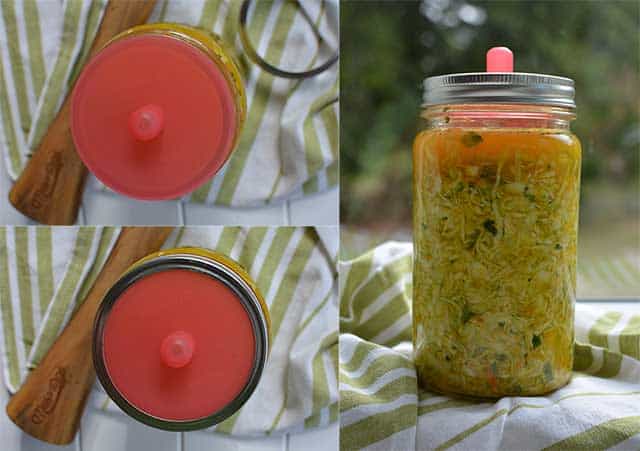
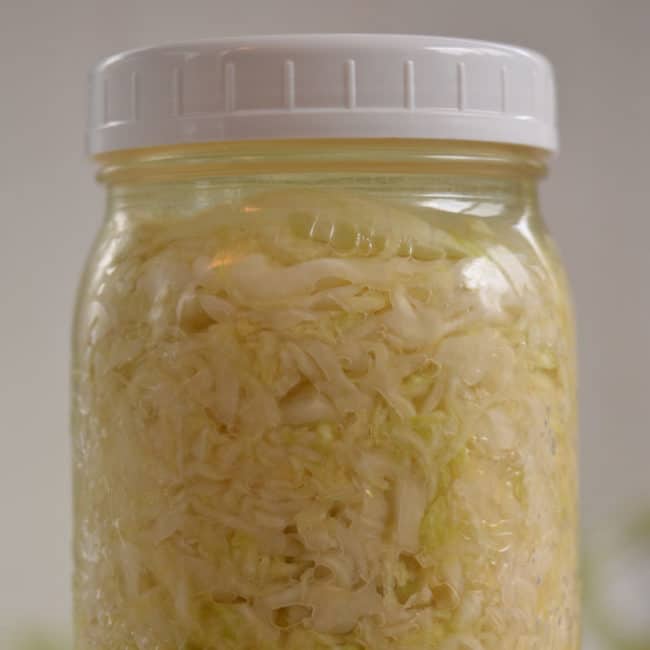
During the first week of fermentation, when there is plenty of brine, the Pickle Pebble works to hold everything under the brine.
However, once the active first week of fermentation passes, the packed sauerkraut is no longer below the brine.

I use a fermentation spring when making sauerkraut. Everything stays below the brine for the duration of fermentation.
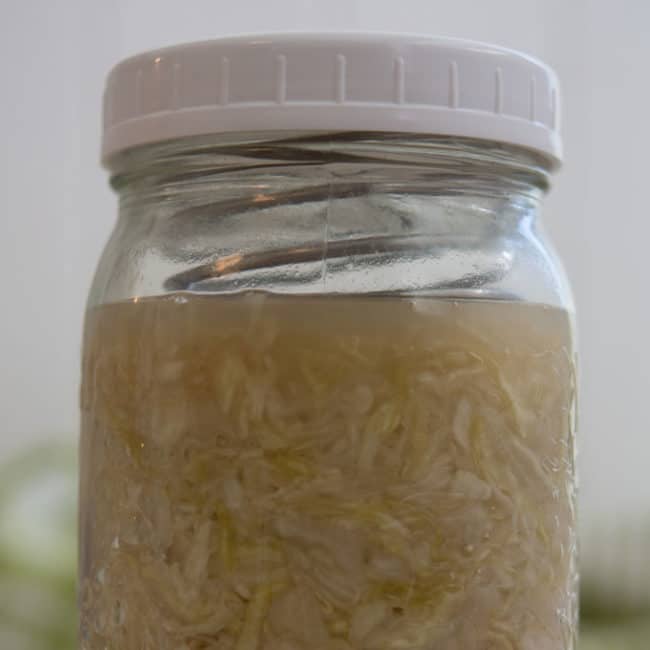
Use a fermentation spring for sauerkraut and save the Pickle Pebble for pickles.
Can You Use Pickle Pebbles with Pickles (Fermented Vegetables)?
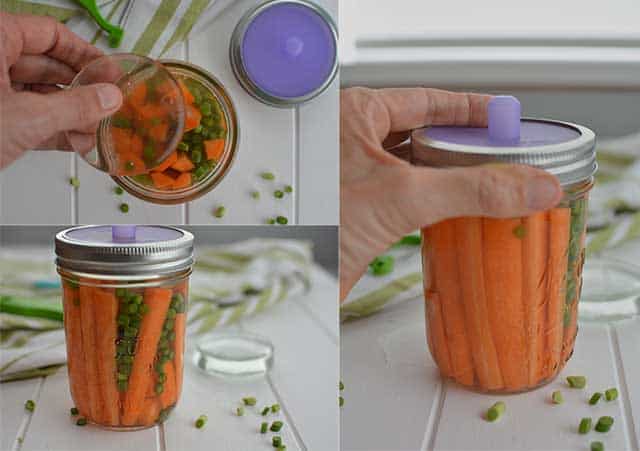
When I was putting together my In A Pickle! course and developing recipes using a range of vegetables, I found that the Pickle Pebble worked with most of them.
The gases created during the fermentation of vegetables find their way up and out of the brine, thereby not causing the packed vegetable to “heave.” The weight of the Pickle Pebble is enough to keep everything safely under the brine.
I tried using my trusty fermentation spring but found that it squished softer vegetables such as cucumbers and zucchini.
When using a Pickle Pebble, be sure to use the recommended 1-inch (25 mm) headspace to leave enough room for your brine.
How Well Do Pickle Pebbles Work with Pastes and Relishes?
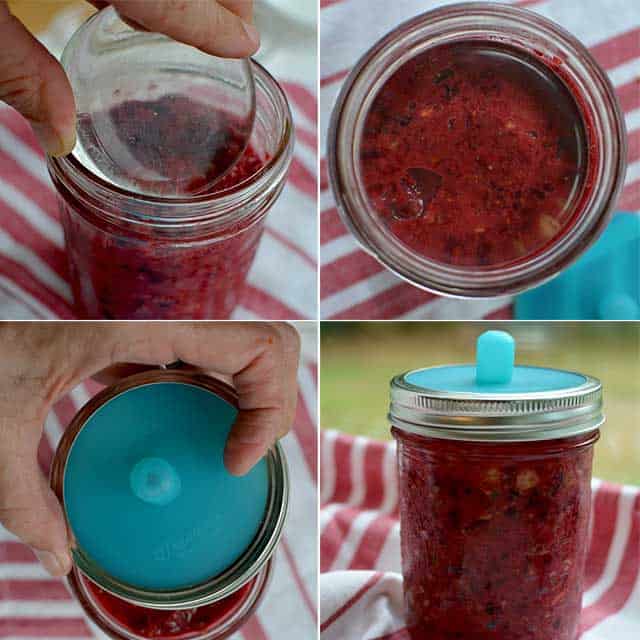
With a thick relish, paste, or chutney, you usually do not end up with brine.
For these types of ferments, I use a folded piece of parchment paper to keep surface air at bay. No weight is necessary, though I sometimes use the Kraut Souce fermentation lid that has a small plate to push down on the paste.
Can You Use Mastontops with Watery Ferments?
I don’t know what I was thinking when I tried to use a Pickle Pebble in my fermented cabbage juice (test recipe). Such a mixture is way too watery to support any weight. This jar is half cabbage and half brine!
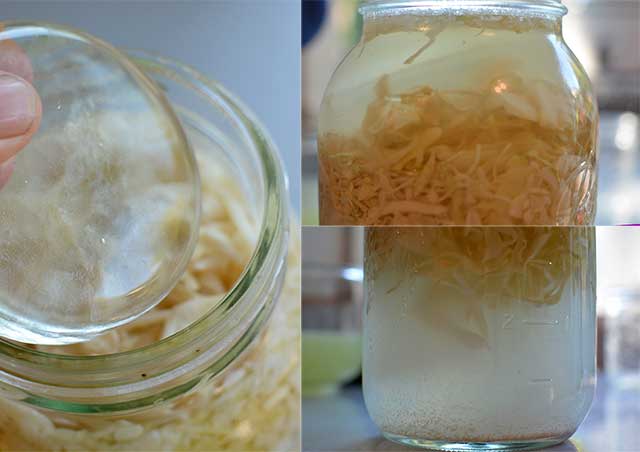
Other Fermentation Products to Consider
No one fermentation weight will be perfect for every occasion. Select the best fermentation weight for what you are making.
My reviews on other weights, along with airlocks. for fermenting include:
The PickleHelix Fermentation Kit by Trellis Review [INNOVATIVE]
Kraut Source Fermentation Lid REVIEW [Solid Design]
ViscoDisc Canning Buddies REVIEW [Simple & Affordable]
Pickle-Pushing No-Float Jar-Packer Review: Ingenious
For homemade weight options, see: Fermentation Weights: Keep Your Ferments Below the Brine
Masontops Pickle Pebble and Pickle Pipes FAQs
Pickle Pipes are used as airlocks for fermenting vegetables in Mason jars.
During the fermentation process, lactic acid bacteria break down the natural sugars in vegetables and produce carbon dioxide gas.
The Pickle Pipe is a one-way valve that allows gas to escape while preventing oxygen from entering the jar.
Pickle Pipes can be washed in the dishwasher or gently washed by hand.
Silicone will absorb odors, especially garlic, onions, and hot peppers, but I have you covered: Best Way to Remove Odors from Plastic and Silicone [2 ESSENTIAL KEYS]
According to the manufacturer, Masontops, both can be washed in the dishwasher.
If you have used Pickle Pebbles or Pickle Pipes, feel free to share your experience in the Comments.
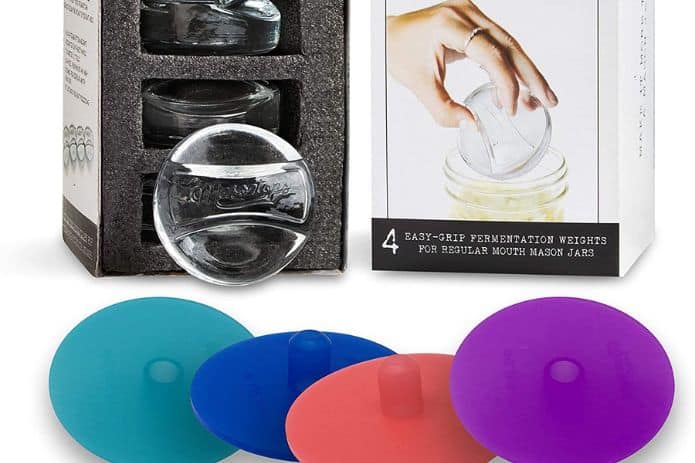
Last update on 2024-07-26 / Affiliate links / Images from Amazon Product Advertising API

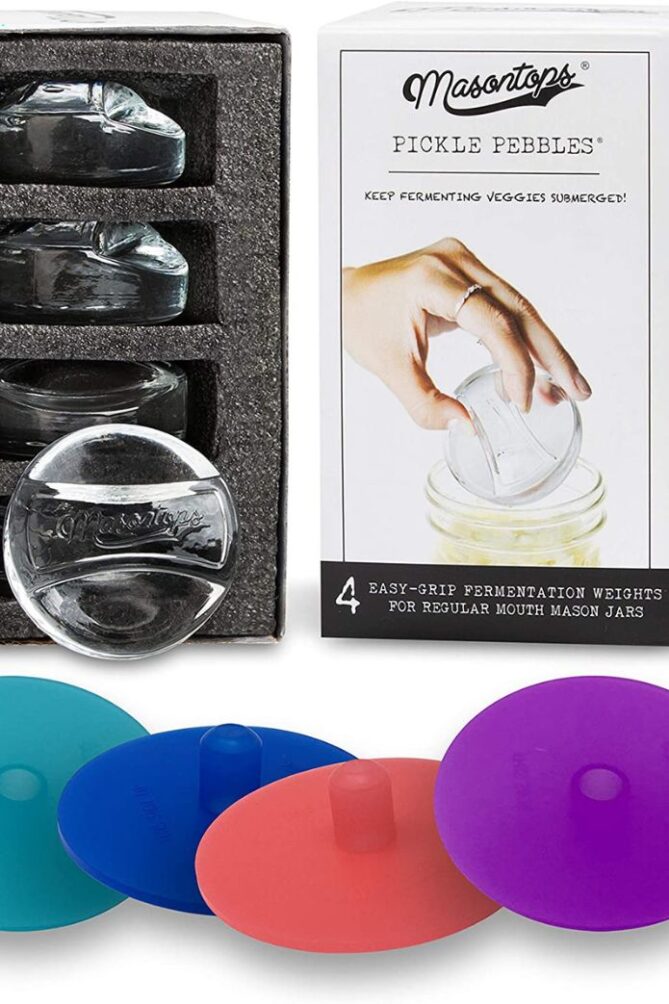

 This post may contain affiliate links which won’t change your price but will share some commission.
This post may contain affiliate links which won’t change your price but will share some commission.
